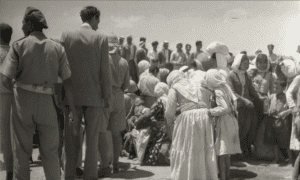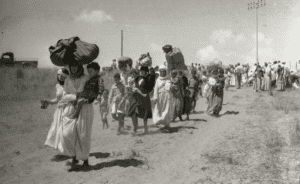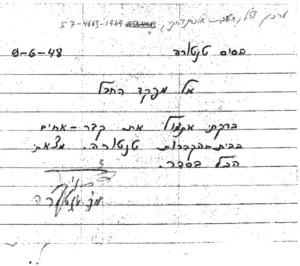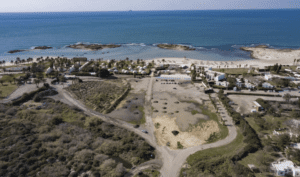There’s a Mass Palestinian Grave at a Popular Israeli Beach, Veterans Confess

Aerial view of Dor beach and its parking lot in Israel, built over the mass grave of the Palestinian massacre victims of Tantura, 1948.
“I was a murderer. I didn’t take prisoners,” admitted an Israeli combat soldier present for the June 1948 massacre in the Palestinian town of Tantura. “I had a machine gun with 250 bullets. I can’t say how many [I killed].”
by Adam Raz, reposted from Ha’aretz, January 20, 2022
“They silenced it,” the former combat soldier Moshe Diamant says, trying to be spare with his words. “It mustn’t be told, it could cause a whole scandal. I don’t want to talk about it, but it happened. What can you do? It happened.”
Twenty-two years have passed since the furor erupted over the account of what occurred during the conquest by Israeli troops of the village of Tantura, north of Caesarea on the Mediterranean coast, in the War of Independence. The controversy sprang up in the wake of a master’s thesis written by an Israeli graduate student named Theodore Katz, that contained testimony about atrocities perpetrated by the Alexandroni Brigade against Arab prisoners of war.
The thesis led to the publication of an article in the newspaper Maariv headlined “The Massacre at Tantura.” Ultimately, a libel suit filed against Katz by veterans of the brigade induced him to retract his account of a massacre.
For years, Katz’s findings were archived, and discussion of the episode took the form of a professional debate between historians. Until now. Now, at the age of 90 and up, a number of combat soldiers from the Israel Defense Forces’ brigade have admitted that a massacre did indeed take place in 1948 at Tantura – today’s popular Dor Beach, adjacent to Kibbutz Nahsholim.
The former soldiers describe different scenes in different ways, and the number of villagers who were shot to death can’t be established. The numbers arising from the testimonies range from a handful who were killed, to many dozens. According to one testimony, provided by a resident of Zichron Yaakov who helped bury the victims, the number of dead exceeded 200, though this high figure does not have corroboration.
Tantura massacre confessions
According to Diamant, speaking now, villagers were shot to death by a “savage” using a submachine gun, at the conclusion of the battle. He adds that in connection with the libel suit in 2000, the former soldiers tacitly understood that they would pretend that nothing unusual had occurred after the village’s conquest. “We didn’t know, we didn’t hear. Of course everyone knew. They all knew.”
Another combat soldier, Haim Levin, now relates that a member of the unit went over to a group of 15 or 20 POWs “and killed them all.” Levin says he was appalled, and he spoke to his buddies to try to find out what was going on. “You have no idea how many [of us] those guys have killed,” he was told.

Another combat soldier in the brigade, Micha Vitkon, talked about an officer “who in later years was a big man in the Defense Ministry. With his pistol he killed one Arab after another. He was a bit disturbed, and that was a symptom of his disturbance.” According to Vitkon, the soldier did what he did because the prisoners refused to divulge where they had hidden the remaining weapons in the village.
Another combat soldier described a different incident that occurred there: “It’s not nice to say this. They put them into a barrel and shot them in the barrel. I remember the blood in the barrel.” One of the soldiers summed up by saying that the his comrades-in-arms simply didn’t behave like human beings in the village – and then resumed his silence.
Coerced apology for truth-telling about Tantura massacre
These and other testimonies appear in an impressive documentation project of the director Alon Schwarz. His documentary film “Tantura,” which will be screened twice this weekend online as part of the Sundance Film festival in Utah, would seem to undo the version that took root following the libel suit and Katz’s apology.
Even though the testimonies of the soldiers in the film (some of them recorded by Katz, some by Schwarz) were given in broken sentences, in fragments of confessions, the overall picture is clear: Soldiers in the Alexandroni Brigade massacred unarmed men after the battle had concluded.
In fact, the testimony Katz collected was not presented to the court during the libel trial, which was settled midway through the proceedings. Listening to those recordings suggests that if the court had probed them at the time, Katz would not have been impelled to apologize. Often what the soldiers told him was only hinted at and partial, but together it added up to an unequivocal truth.
“What do you want?” asked Shlomo Ambar, who would rise to the rank of brigadier general and head of Civil Defense, the forerunner of today’s Home Front Command. “For me to be a delicate soul and speak in poetry? I moved aside. That’s all. Enough.” Ambar, speaking in the film, made it clear that the events in the village had not been to his liking, “but because I didn’t speak out then, there is no reason for me to talk about it today.”

One of the grimmest testimonies in Schwarz’s film is that of Amitzur Cohen, who talked about his first months as a combat soldier in the war: “I was a murderer. I didn’t take prisoners.” Cohen relates that if a squad of Arab soldiers was standing with their hands raised, he would shoot them all. How many Arabs did he kill outside the framework of the battles? “I didn’t count. I had a machine gun with 250 bullets. I can’t say how many.”
The Alexandroni Brigade soldiers’ testimonies join past written testimony provided by Yosef Ben-Eliezer. “I was one of the soldiers involved in the conquest of Tantura,” Ben-Eliezer wrote, some two decades ago. “I was aware of the murder in the village. Some of the soldiers did the killing at their own independent initiative.”
Mass grave: “They took care to hide it”
The testimonies and documents that Schwarz collected for his film indicate that after the massacre the victims were buried in a mass grave, which is now under the Dor Beach parking lot. The grave was dug especially for this purpose, and the burial went on for more than a week.
At the end of May 1948, a week after the village was conquered, and two weeks after the declaration of statehood, one of the commanders who was posted at the site was reprimanded for not having dealt properly with the burial of the Arabs’ bodies.
On June 9, the commander of the adjacent base reported: “Yesterday I checked the mass grave in Tantura cemetery. Found everything in order.”
In addition to the testimonies and documents, the film presents the conclusion of experts who compared aerial photographs of the village from before and after its conquest. A comparison of the photographs, and the use of three-dimensional imaging done with new tools, makes it possible not only to determine the exact location of the grave but also to estimate its dimensions: 35 meters long, 4 meters wide.
“They took care to hide it,” Katz says in the film, “in such a way that the coming generations would walk there without knowing what they were stepping on.”

“Disqualified”
The confession of the Alexandroni Brigade troops casts a new light on the dismal attempt to silence Teddy Katz.
In March 1998, while a graduate student at the University of Haifa, Katz submitted a master’s thesis to the department of Middle Eastern history. Its title: “The Exodus of the Arabs from the Villages at the Foot of Southern Mount Carmel in 1948.”
Katz, then in his fifties, received a grade of 97. According to custom, the paper was deposited in the university’s library, and the author intended to proceed to doctoral studies. But his plan went awry.
In January 2000, journalist Amir Gilat borrowed the study from the library and published an article about the massacre in Maariv. It touched off a firestorm.
Besides the libel suit initiated by the Alexandroni veterans association, the university also went into a tizzy, and decided to set up a committee to reexamine the M.A. thesis.
Even though the original reviewers found that Katz had completed the thesis with excellence, and even though the paper was based on dozens of documented testimonies – of Jewish soldiers and Arab refugees from Tantura – the new committee decided to disqualify the thesis.
Katz’s paper is not fault-free, but probably the primary target of criticism is the University of Haifa, which accompanied the research and the writing in a deficient manner, and after approving it then reversed course and disowned its student. That made possible the years-long silencing and repression of the bloody events in Tantura.
For Katz, one court hearing was all it took for him to sign a letter of apology in which he declared that there had not been a massacre in the village and that his thesis was flawed. The fact that just hours later he retracted this, and that his lawyer, Avigdor Feldman, was not present at the nighttime meeting in which Katz came under pressure to recant, was forgotten. The apology buried the findings the thesis had uncovered, and the details of the massacre were thereafter not subjected to comprehensive scrutiny.
Was Tantura a massacre? Historians’ opinions
The historians who addressed the episode – from Yoav Gelber to Benny Morris and Ilan Pappé – reached different and contradictory conclusions. Gelber, who played a key role in the struggle to discredit Katz’s paper, asserted that a few dozen Arabs had been killed in the battle itself, but that a massacre had not occurred.
Morris, for his part, thought that it was impossible to determine unequivocally what happened, but wrote that after reading several of the testimonies and interviewing some of the Alexandroni veterans, he “came away with a deep sense of unease.”
Pappé, who engaged in a highly publicized debate with Gelber over Katz’s thesis, determined that a massacre had been perpetrated in Tantura in the straightforward sense of the word. Now, with the appearance of the testimony in Schwarz’s film, the debate would seem to be decided.

In one of the more dramatic scenes in the documentary, Drora Pilpel, who was the judge in the libel suit against Katz, listens to a recording of one of Katz’s interviews. It was the first time she had encountered the testimony collected by Katz, whose speedy apology brought the trial to a quick end. “If it’s true, it’s a pity,” the retired judge tells the director after removing her headphones. “If he had things like this, he should have gone all the way to the end.”
Time to stop pretending
The Tantura [massacre] affair exemplifies the difficulty that soldiers in the 1948 war had in acknowledging the bad behavior that was on display in that war: acts of murder, violence against Arab residents, expulsion and looting. To listen to the soldiers’ testimony today, while considering the uniform stand they demonstrated when they sued Katz, is to grasp the potency of the conspiracy of silence and the consensus that there are things one doesn’t talk about.
It’s to be hoped that from the perspective of years, such subjects will be more readily addressed. A possibly encouraging sign in this direction is the fact that the film about Tantura received funding from such mainstream bodies as the Hot cable network and the New Fund for Cinema and Television.
A possibly encouraging sign in this direction is the fact that the film about Tantura received funding from such mainstream bodies as the Hot cable network and the New Fund for Cinema and Television.
The grim events at Tantura will never be completely investigated, the full truth will not be known. However, there is one thing that can be asserted with a great deal of certainty: Under the parking lot of one of the most familiar and beloved Israeli resort sites on the Mediterranean, lie the remains of the victims of one of the glaring massacres of the War of Independence.
Adam Raz is a researcher at the Akevot Institute for Israeli-Palestinian Conflict Research. The Akevot Institute assisted the filmmaker (without remuneration).
ESSENTIAL READING ON ISRAELI MASSACRES:
- Israeli Massacres: A Brief and Shocking History
- 25 years after an Israeli massacred 29 Palestinians, victims are still being punished
- Four Decades of Twisting Facts About Israel’s Attack on the USS Liberty
RELATED READING:
- Israel kills children, doctors in horrific nighttime massacre
- Blinken reveals how Obama & Biden helped Israel’s 2014 Gaza massacre
- Gideon Levy: Israel’s massacre of family is a war crime
- 2021 was deadliest year for Palestinian children since 2014
- From the ruins of Jenin, the truth about an atrocity
VIDEOS:
- Trailer for Tantura
- MASS MURDER IN GAZA
- Watch: Headlines from Gaza – Massacre in Gaza Continues
- Israel Palestine Basics


Geen opmerkingen:
Een reactie posten